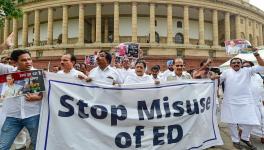Centre All Set to Table Transgender Bill, 2016, Activists and Transgender Want It to be Struck Down

As the Centre is all set to table the Transgender Persons (Protection of Rights) Bill 2016, the activists and transgender community remind us why we should pay urgent attention to the particular bill.
Why India’s transgender community, which is around 4.8 million in numbers, is up in arms?
The text of the bill begins with the inaccurate and outrageous definition of “Transgender” that defines them as “a person who is neither wholly female nor wholly male; or a combination of female or male; or neither female nor male; and whose sense of gender does not match with the gender assigned to that person at the time of birth, and includes trans men and trans women, persons with intersex variations and gender-queers”.
Sampoorna, the organization for trans and intersex people, defines transgender persons as those "individuals who are socially, legally and medically categorized as being either male or female, but who assert that this is not their self-identity and /or expression. Transgender people may or may not be intersex”.
While speaking to Newsclick, Nitasha Biswas, the winner of Miss Transqueen 2017, said: “transgender and intersex are not interchangeable terms at all and it’s problematic for this Bill to say so”.
Commenting on the definition of Transgender as per the Bill, Nitasha expressed her strong view on it by saying “Gender is not in between your legs.”
Even more horribly, the bill says that the “transgender person must obtain a certificate of identity as proof of recognition of identity as a transgender person and to invoke rights under the Bill”. The District Magistrate would grant such certificates on the recommendation of a Screening Committee which comprise a medical officer, a psychologist or psychiatrist, a district welfare officer, a government official, and a transgender person.
Commenting on this clause, Nitasha said: “These clearly go against the Supreme Court’s own ruling that people have the right to gender self-identification”.
In its landmark National Legal Services Authority (NALSA) judgment, the National Legal Services Authority vs. Union of India judgment, the Supreme Court in February 2014, held that the individuals had the right to the self-identification of their sexual orientation. The court also observed that the fundamental rights enjoyed under the Constitution are equally applicable to transgenders.
Portraying the level of insult one would need to face during the certificate obtaining process, Nitasha added that the government should focus on the empowerment of this community by providing education, healthcare system and proper rehabilitation. She also pointed out that the Bill is less ambitious about the healthcare.
The trans communities were unanimously raising this point that ‘the provision of district screening committees must be struck down’.
Yet again the Bill says that “whoever,—(a) compels or entices a transgender person to indulge in the act of begging or other similar forms of forced or bonded labour other than any compulsory service for 20 public purposes imposed by Government shall be punishable with imprisonment for a term which shall not be less than six months but which may extend to two years and with fine”.
Demanding the complete removal of this clause, the organisations such as Sampoorna pointed out, “It will lead to the further criminalisation of vulnerable trans communities struggling to make a livelihood”.
Most surprisingly, the Bill does not take any notes to curb the specific violence that the trans community faces.
Progress of the Transgender Bill
The transgender bill was tabled in the Lok Sabha by Thaawarchand Gehlot, the Minister for Social Justice and Empowerment in August 2016. The blueprint for the bill has been drawn from the NALSA judgment of Supreme Court in February 2014.
In December 2014, Tiruchi Siva, a Dravida Munnetra Kazhagam (DMK) Rajya Sabha MP had taken efforts for the framing the Bill. As the part of it, Siva introduced the Rights of Transgender Persons Bill, 2014, as a Private Member’s Bill in the Rajya Sabha. Even though it was unanimously passed in the Upper House, it was never debated in the Lok Sabha.
The Bill which was passed by the Rajya Sabha contained many progressive notes including the creation of institutions like the National and State Commissions for transgenders. The Bill also suggested the transgender rights courts.
The government drafted the Rights of Transgender Persons Bill, 2015, without including all these remedial measures to prevent sexual discrimination against the community. Although the main framework of the 2015 draft Bill was borrowed from the previous one. The draft was sent to the Law ministry after consulting with legal experts and transgender activists. With considerable revisions in the draft, it was tabled in the Lok Sabha by Thaawarchand Gehlot, the Minister for Social Justice and Empowerment, in August 2016.
Though the parliamentary committee has slammed the Bill on the definition of transgender’ used in the Transgender Persons (Protection of Rights) Bill, 2016, the Centre is all set to reintroduce the original version of the Bill.
Get the latest reports & analysis with people's perspective on Protests, movements & deep analytical videos, discussions of the current affairs in your Telegram app. Subscribe to NewsClick's Telegram channel & get Real-Time updates on stories, as they get published on our website.
























